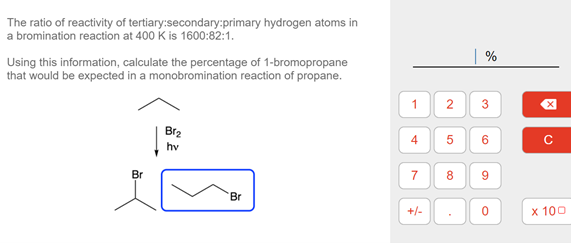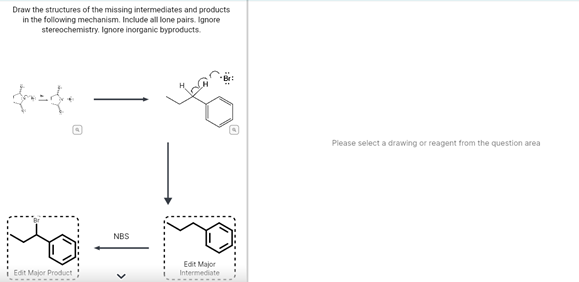The ratio of reactivity of tertiary:secondary:primary hydrogen atoms in a bromination reaction at 400 K is 1600:82:1. Using this information, calculate the percentage of 1-bromopropane that would be expected in a monobromination reaction of propane. Br2 hv Br Br
The ratio of reactivity of tertiary:secondary:primary hydrogen atoms in a bromination reaction at 400 K is 1600:82:1. Using this information, calculate the percentage of 1-bromopropane that would be expected in a monobromination reaction of propane. Br2 hv Br Br
Chemistry
10th Edition
ISBN:9781305957404
Author:Steven S. Zumdahl, Susan A. Zumdahl, Donald J. DeCoste
Publisher:Steven S. Zumdahl, Susan A. Zumdahl, Donald J. DeCoste
Chapter1: Chemical Foundations
Section: Chapter Questions
Problem 1RQ: Define and explain the differences between the following terms. a. law and theory b. theory and...
Related questions
Question

Transcribed Image Text:The ratio of reactivity of tertiary:secondary:primary hydrogen atoms in
a bromination reaction at 400 k is 1600:82:1.
%
Using this information, calculate the percentage of 1-bromopropane
that would be expected in a monobromination reaction of propane.
Br2
4
hv
Br
8.
9.
Br
+/-
x 100
2.
5
7.

Transcribed Image Text:Draw the structures of the missing intermediates and products
in the following mechanism. Include all lone pairs. Ignore
stereochemistry. Ignore inorganic byproducts.
Please select a drawing or reagent from the question area
NBS
Edit Major
Intermediate
Edit Major Product
Expert Solution
This question has been solved!
Explore an expertly crafted, step-by-step solution for a thorough understanding of key concepts.
This is a popular solution!
Trending now
This is a popular solution!
Step by step
Solved in 2 steps with 2 images

Knowledge Booster
Learn more about
Need a deep-dive on the concept behind this application? Look no further. Learn more about this topic, chemistry and related others by exploring similar questions and additional content below.Recommended textbooks for you

Chemistry
Chemistry
ISBN:
9781305957404
Author:
Steven S. Zumdahl, Susan A. Zumdahl, Donald J. DeCoste
Publisher:
Cengage Learning

Chemistry
Chemistry
ISBN:
9781259911156
Author:
Raymond Chang Dr., Jason Overby Professor
Publisher:
McGraw-Hill Education

Principles of Instrumental Analysis
Chemistry
ISBN:
9781305577213
Author:
Douglas A. Skoog, F. James Holler, Stanley R. Crouch
Publisher:
Cengage Learning

Chemistry
Chemistry
ISBN:
9781305957404
Author:
Steven S. Zumdahl, Susan A. Zumdahl, Donald J. DeCoste
Publisher:
Cengage Learning

Chemistry
Chemistry
ISBN:
9781259911156
Author:
Raymond Chang Dr., Jason Overby Professor
Publisher:
McGraw-Hill Education

Principles of Instrumental Analysis
Chemistry
ISBN:
9781305577213
Author:
Douglas A. Skoog, F. James Holler, Stanley R. Crouch
Publisher:
Cengage Learning

Organic Chemistry
Chemistry
ISBN:
9780078021558
Author:
Janice Gorzynski Smith Dr.
Publisher:
McGraw-Hill Education

Chemistry: Principles and Reactions
Chemistry
ISBN:
9781305079373
Author:
William L. Masterton, Cecile N. Hurley
Publisher:
Cengage Learning

Elementary Principles of Chemical Processes, Bind…
Chemistry
ISBN:
9781118431221
Author:
Richard M. Felder, Ronald W. Rousseau, Lisa G. Bullard
Publisher:
WILEY